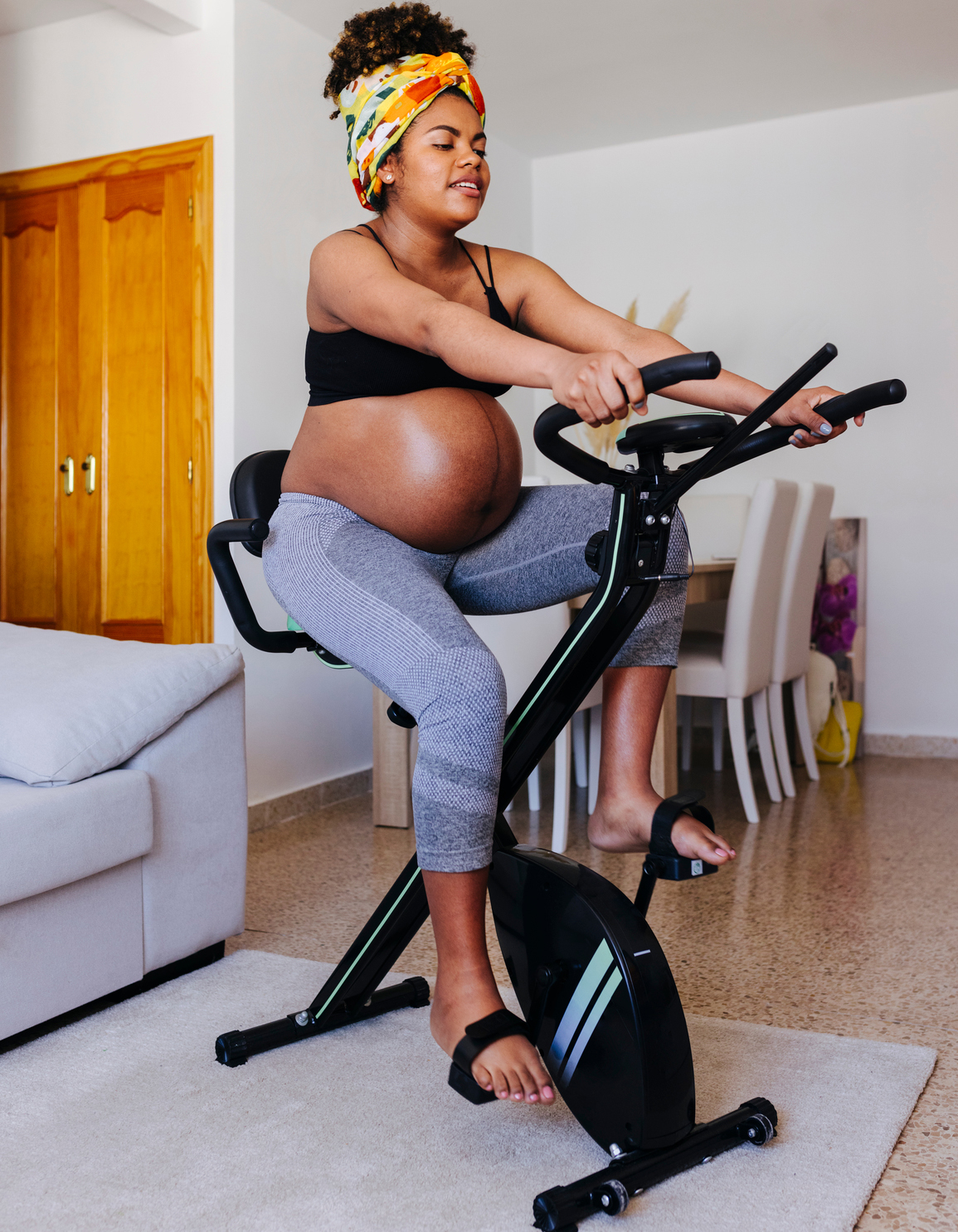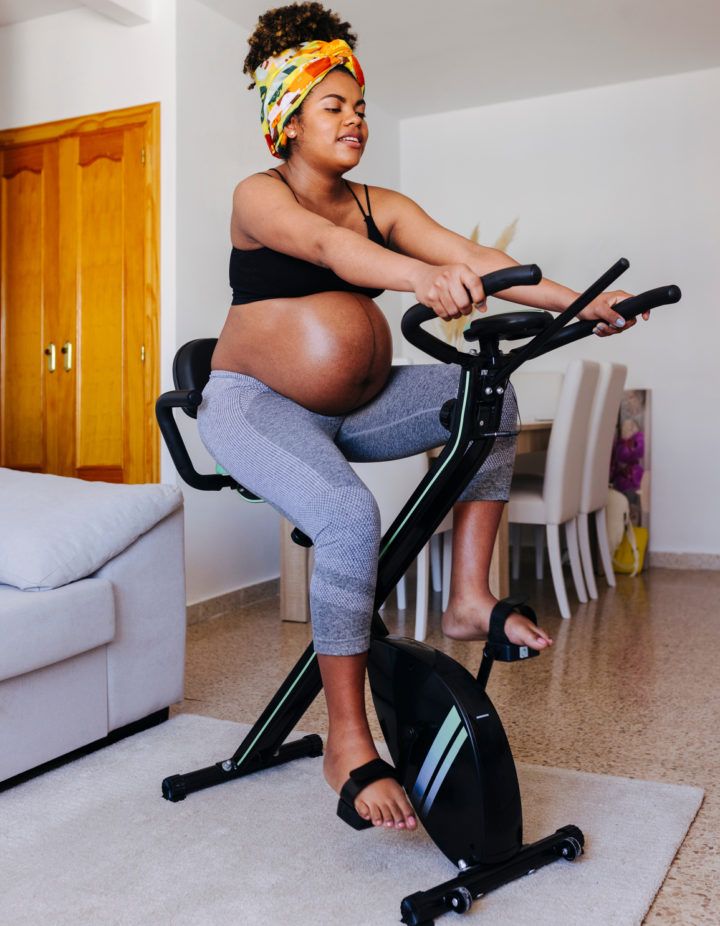Just found out you’re expecting? Huge congrats are in order! But then comes the big question: What now?
Exercise during pregnancy is touted as being incredibly beneficial for both you and your little one (and trust us, it truly is!), but a quick dive into the depths of Google can leave you scratching your head. From debates over the benefits of kegels to warnings about diastasis recti (a fancy term for abdominal separation), you might start thinking it’s safer to encase yourself in bubble wrap for the next nine months. It can feel overwhelming, to say the least.
But there’s no need to panic! Having coached thousands of pre and postnatal women, we’re here to cut through the confusion and guide you with expert advice. Let’s navigate this journey together, minus the bubble wrap!
1. Diaphragmatic Breathing
Yep – the thing we innately do is the most important thing to do during pregnancy. But, for many of us, we recruit a “faulty” breathing pattern when stressed, pregnant or just, ya know, life(!) where we breathe into our chest instead of into our belly and diaphragm.
This becomes especially important during pregnancy because of the extra pressure put on your pelvic floor and core during pregnancy (because of the growing baby). Therefore, we want to learn how to belly breathe and relax our pelvic floor and core on the inhale and then engage our pelvic floor and core on the exhale.
Diaphragmatic breath breakdown:
On the inhale breath through your nose and imagine an umbrella expanding 360 in your ribcage and imagine your pelvic floor dropping down to the basement.
On the exhale blow as if you are blowing through a straw and imagine picking a blueberry up through your vagina and up to your belly button!
2. The Truth About Kegels
To kegel or not to kegel, that is the question! So here is the deal, for most women when we think of kegels we think of tightening and squeezing our vaginal and anal muscles (stopping flow of urine – please don’t do this btw!).
But we want our pelvic floor to be dynamic just like any other muscle group. It should be strong to maintain pelvic floor function (maintaining urine, holding up your organ, sexual function,etc.) but we also need it to know how to relax! Not only because that is where the baby needs to exit from (other than a C-section birth) but because an over-engaged pelvic floor is not necessarily a strong pelvic floor! It’s kind of like an elevator being stuck on the 3rd floor – that’s not a properly functioning elevator.
When you get closer to 34-36 weeks into pregnancy you can place greater emphasis on the softening/relaxation of your pelvic floor but for movement, life, and to minimize aches, pains and pelvic floor dysfunction we want your pelvic floor to be dynamic and strong!
3. Prioritize your pelvic floor
We know life gets busy, especially for parents, so we don’t expect you to be thinking about “picking up a blueberry” every time you pick up your child. However, by practicing optimal form and learning how to properly utilize the diaphragmatic breath (thinking of exhaling on exertion or “blow before you go”) and incorporating your pelvic floor and core in movement, eventually allows this type of breathing to go back to more of a habitual state so that when you are healing postpartum and in the day to day throws of life and motherhood your body is working more optimally.
The pelvic floor, core and glutes are all kind of BFF’s. They work in unison and as a support system for each other, so we recommend workouts that not only work on the functional movements you will be doing as a mom but also with a strong emphasis on pelvic floor, core and glute activation. A simple way to make every exercise a core and pelvic floor exercise? You’ve got…diaphragmatic breathing! Broken record we know…
4. Don’t be afraid of Diastasis Recti (abdominal separation)
Your core and pelvic floor go through a large amount of stress during pregnancy to accommodate your growing baby. Your linea alba (connective tissue that connects your rectus abdominis – “6 pack abs”) stretches to accommodate this growth. This is a normal and natural part of pregnancy and 100% of women will have some amount of separation in-between their abdominal wall to accommodate this expansion.
Core exercises like paloff press, bird dogs, elevated plank taps, kneeling wood chops and other exercises that not only have less risk of outward pressure on that already stretched linea alba but they also help you maintain strength and connection through your core which is the most important part of healing or minimizing your chance of diastasis recti!
So how do you know if you have too much pressure outwards? Luckily our body gives us a sign. You will see a doming/coning down the center of your belly (it kind of looks like a shark fin or an alien popping out of your abdomen). Now if you see this don’t fret – it’s nothing to be scared off – it just means there might be a modification that needs to be made.
5. Work with someone who knows about pre/postnatal fitness
Unfortunately, it is a common trend that when a fitness professional becomes pregnant they suddenly come out with a prenatal fitness program. Every pregnancy is different, so just because a fitness professional becomes pregnant and figures out what works for her body, does not mean it will work for you, nor does it mean that they have the proper education to guide someone through their pregnancy. For example, our trainers at The Lotus Method go through an extensive training program that addresses all physiological changes that occur during pregnancy and postpartum, from hormonal adaptation, cardiovascular changes, structural changes, pelvic floor and core adaptation, birthing protocols, all the way down to the mental health aspect.
Make sure that whomever you are working with or whom’s program you are following has an extensive depth of knowledge about the pre/postnatal body and can truly support you on your individual journey. First hand experience is great, but working with thousands of individual case studies is better. Ask your instructor for their qualifications (certs, years of experience working with prenatal women, etc) and if they aren’t making individual adjustments for you and your needs, find somebody who will!
6. Listen to your body’s needs
As we’ve mentioned, every pregnancy and postpartum journey is so different & that’s the beauty of it all! Therefore, what may work for you one pregnancy may not work during your next pregnancy. Same thing applies to other women’s pregnancies. Your neighbor down the street might be still running during her pregnancy, doing Barry’s and wilding out! While you are having pain walking down the street or putting on your pants…please remember, that doesn’t mean anything is wrong with you and you did nothing wrong.
There are a variety of factors why some women have aches and pains, pelvic floor dysfunction or not, diastasis recti (abdominal separation) or not or how long they may be able to maintain pre-pregnancy activity. It’s important to listen to your body and adjust accordingly, pushing through warning signs like pain, discomfort, coning/doming (discussed above), pelvic pain, leakage, etc., only sets up for a longer recovery postpartum and a longer amount of time until you can return to the activities you love.
If you are experiencing any of these symptoms this is a way your body is communicating with you, telling you some changes need to be made. Ignoring these symptoms and chalking them up as a “normal” part of pregnancy can cause more harm than good and leave you dealing with lingering pains/symptoms. While aches and pains, leakage, pelvic floor heaviness may be common, but they are not “normal” and there is help!
7. Be ok with making modifications
It’s no secret by now that we are huge advocates for exercise during pregnancy. There are countless benefits such as less pelvic pain, quicker postpartum recovery, lower odds of delivery complications, improved health benefits for the baby, building strength and endurance for labor, better sleep and much more!
Now there are many anatomical changes happening within your body while you are pregnant, so expecting to be able to continue your normal exercise routine isn’t necessarily reasonable. When you look at the risk vs. rewards of certain exercises it will make more sense.
When a prenatal woman performs a high intensity exercise like burpees, running or jumping of sorts, this high impact can add excess pressure (and hello, your baby is already like a bowling bowl chilling on your pelvic floor) so we want to avoid adding excess pressure on it! We can still increase your intensity by increasing tempo while focusing on your breath and pelvic floor connection making sure each movement is done with proper form and alignment. Check out this video for some swaps we like to encourage our clients to make!
8. Have fun!
You can still have a challenging, fun and smart workout during pregnancy even with listening to your body, making some modifications and imagining picking a blueberry up through your vagina (refer to tip #1 if you have no idea what we’re talking about ). You do not need to be in bubble wrap during your pregnancy. Anybody who treats you with kit gloves must not feel comfortable training pregnant women. All these tips are about setting YOU up for the best pregnancy, labor and postpartum experience possible. Know that moving your body is good for you, your baby, and your mental sanity, so that sounds like win, win, win to us! Enjoy and we hope this helps you move with more confidence during your pregnancy!
Caitlin Ritt is the founder and CEO of The Lotus Method and Mallory Risner is a pre/postnatal expert at The Lotus Method and the Head of Social Media. The Lotus Method is personalized fitness designed specifically for motherhood by pre/postnatal experts. The Lotus Method has been helping thousands of new and expecting motherhood for almost 9 years have prepare for the demands of labor, pregnancy and motherhood at our brick and mortar studios (San Francisco & New York) and virtually around the world.




